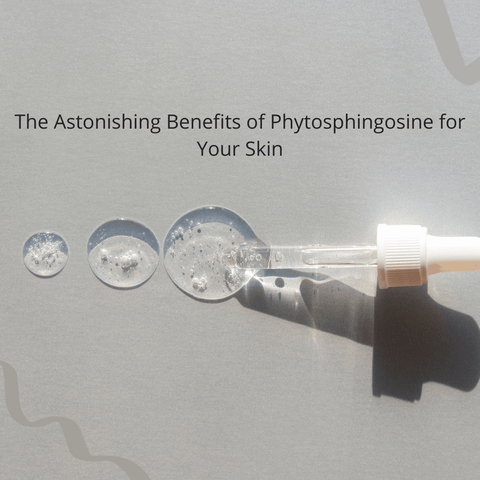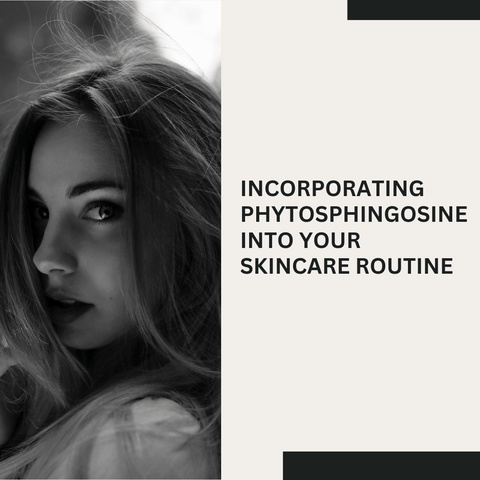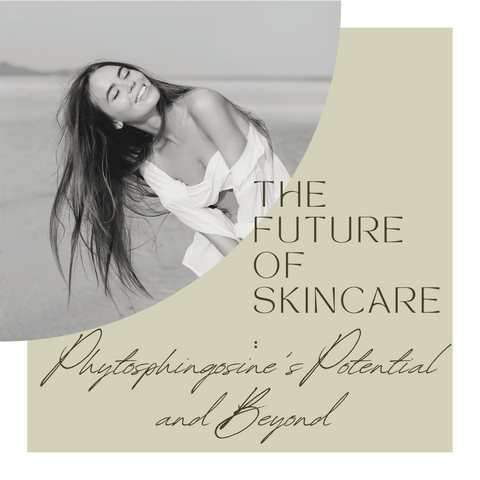In the field of skincare, phytosphingosine is a lesser-known but powerful substance. It is a sphingolipid, which is a type of lipid that is crucial to the skin's lipid barrier. Phytosphingosine has received attention for its potential benefits in boosting skin health and resolving a variety of skincare issues. This blog provides an introduction to phytosphingosine and its role in skincare.
Understanding Phytosphingosine: Nature's Gift to Your Skin

Phytosphingosine is a natural chemical that aids in the health and function of your skin. It belongs to the sphingolipid family, which also contains ceramides, sphingosine, and other lipids found in the stratum corneum of the skin. Phytosphingosine has a number of skin benefits, including barrier function, anti-inflammatory properties, acne management, anti-aging benefits, hydration, and a soothing effect. If you have specific skincare goals or concerns, visit a dermatologist for personalised product suggestions and counselling.
What is Phytosphingosine and How Does It Work?
Phytosphingosine is a naturally occurring lipid substance found in the skin, notably in the stratum corneum, the skin's outermost layer. It belongs to the sphingolipid family, along with ceramides, sphingosine, and other lipids. Phytosphingosine is essential for preserving skin health and acting as a barrier. Here's how phytosphingosine works and what it can do for you in terms of skincare: barrier function, moisture retention, anti-inflammatory properties, acne management, anti-aging benefits, skin hydration, and soothing effects. It is present in a variety of formulations, including moisturisers, serums, and creams, that are intended to promote skin health, reduce inflammation, and address specific skin conditions. When using phytosphingosine-containing products, it is critical to follow the application and usage instructions on the product label. It can be an important part of a skincare routine, particularly for those who want to maintain a healthy skin barrier, manage skin conditions, or address specific skincare concerns.
The Role of Phytosphingosine in Strengthening the Skin Barrier
Phytosphingosine helps to improve the skin barrier, which is essential for overall skin health and well-being. The skin barrier, which is largely found in the epidermis's outermost layer, termed the stratum corneum, acts as a protective shield against different environmental stresses and aids in skin hydration. Lipid Barrier Component, Enhances Barrier Integrity, Prevents Transepidermal Water Loss (TEWL), Protects Against External Stressors, Supports Skin Healing, Anti-Inflammatory Properties, and Barrier Function Maintenance are some of the ways phytosphingosine helps to strengthen the skin barrier. Including phytosphingosine-containing products in your skincare routine can be especially beneficial for those with sensitive or dry skin, as well as those trying to improve general skin health. These products can assist in strengthening the skin's natural defences, keeping it moisturised, and protecting it from environmental aggressors.
How Phytosphingosine Promotes Moisture Retention and Hydration
Through its involvement in the maintenance of the skin's natural moisture barrier, phytosphingosine promotes moisture retention and hydration. Here's how phytosphingosine helps with barrier integrity, reducing transepidermal water loss (TEWL), preventing dehydration, hydrophilic properties, moisture balance, soothing effect, improved skin function, and anti-aging benefits. Look for moisturisers, serums, and creams that include phytosphingosine to integrate into your skincare routine for moisture retention and hydration. Maintain consistency in your skincare routine, and consider including phytosphingosine-containing products in both your morning and nighttime routines. These products can help strengthen your skin's moisture barrier over time, resulting in enhanced hydration and general skin health.
The Astonishing Benefits of Phytosphingosine for Your Skin

Phytosphingosine has various amazing skin advantages, making it a vital ingredient in skincare products. The following are the primary benefits of including phytosphingosine in your skincare routine:
-
Phytosphingosine aids in moisture retention by strengthening the skin's natural moisture barrier. This minimises water loss, keeping the skin hydrated and preventing dryness.
-
It is essential for maintaining and reinforcing the skin's lipid barrier. A strong barrier protects the skin from environmental stressors such as pollutants, allergens, and pathogens while also reducing moisture evaporation.
-
Transepidermal Water Loss (TEWL) is reduced by phytosphingosine, which prevents water from escaping through the skin's surface. This is critical for preventing skin dehydration and maintaining optimal hydration levels.
-
Phytosphingosine has anti-inflammatory properties, which can help to soothe and calm irritated skin. It is useful for treating redness, itching, and inflammation caused by skin conditions such as eczema, rosacea, and acne.
-
Phytosphingosine has been investigated for its potential in the treatment of acne. It is a useful ingredient in skincare products for people who have acne because it controls sebum production, lessens inflammation, and prevents the growth of bacteria that cause acne.
-
Phytosphingosine can contribute to a more youthful appearance by maintaining the skin's moisture balance and strengthening the barrier. It helps to reduce the appearance of fine lines and wrinkles while also keeping the skin plump and smooth.
-
Phytosphingosine hydrates the skin without leaving an oily or greasy residue. This makes it suitable for a variety of skin types, including oily and combination skin.
-
It has a calming and soothing effect on the skin, making it ideal for people who have sensitive or easily irritated skin.
-
Phytosphingosine promotes overall skin health by improving the skin's ability to protect itself, maintain elasticity, and perform vital functions.
-
Phytosphingosine is a versatile ingredient that can be found in a variety of skincare products, including moisturisers, serums, creams, and cleansers. Its numerous benefits make it an excellent addition to skincare formulations.
Harnessing the Anti-Aging Power of Phytosphingosine
Anti-aging qualities of phytosphingosine can be used to promote a more youthful and vibrant complexion. By incorporating phytosphingosine-containing products into your skincare routine, you can enjoy anti-aging benefits such as fine line and wrinkle reduction, increased skin elasticity, protection against environmental stressors, reduction in skin redness, support for collagen production, prevention of moisture loss, and overall skin health. To make use of phytosphingosine's anti-aging properties:
-
Look for phytosphingosine as an active ingredient in skincare products such as moisturisers, serums, and anti-aging creams.
-
Incorporate phytosphingosine-containing products into your daily skincare routine, applying them as directed.
-
Be patient and consistent with your skincare routine, as significant improvements in the appearance of fine lines and wrinkles may take some time.
Furthermore, combining phytosphingosine with other anti-aging ingredients such as retinol, antioxidants, and peptides can improve its efficacy in addressing various signs of aging. A dermatologist or skincare professional can provide personalised advice on the best products and ingredients to address your specific anti-aging concerns.
Combatting Acne and Blemishes with Phytosphingosine
To battle acne and pimples, phytosphingosine might be an effective supplement to your skincare routine. Because of its specific qualities, it is beneficial for treating many aspects of acne-prone skin. Here's how phytosphingosine can help you fight acne:
-
Regulation of Sebum Production: The ability of phytosphingosine to modulate sebum (skin oil) production has been examined. Excessive sebum production is a common cause of acne. Phytosphingosine can assist in balancing sebum levels, reducing the probability of clogged pores and outbreaks.
-
Anti-Inflammatory Properties: Skin irritation is a common side effect of acne. Anti-inflammatory characteristics of phytosphingosine can help reduce redness, edoema, and the general inflammatory response associated with acne lesions.
-
Acne-Causing Bacteria Inhibition: Phytosphingosine contains antimicrobial properties that can inhibit the growth of acne-causing bacteria, specifically Propionibacterium acnes (P. acnes). By reducing the population of these bacteria on the skin, phytosphingosine aids in the prevention of new acne lesions.
-
Clogged Pores Prevention: Phytosphingosine aids in the maintenance of a healthy skin barrier, which is necessary for preventing pore clogging. Clogged pores, also known as comedones, are a precursor to many acne lesions. A strong barrier keeps pores clear and helps to prevent the formation of blackheads and whiteheads.
-
Soothing Effect: Acne-prone skin is often sensitive and easily irritated. The soothing properties of phytosphingosine can help calm and comfort the skin, reducing the discomfort associated with acne breakouts.
Soothing Inflammation and Healing Skin Conditions with Phytosphingosine
Phytosphingosine contains anti-inflammatory characteristics and can help relieve inflammation and treat a variety of skin disorders. Here's how phytosphingosine can help with inflammation-related skin conditions like redness, eczema and dermatitis, acne inflammation, psoriasis, and sunburn treatment. To reap the benefits of phytosphingosine for inflammation relief and skin healing:
-
Select the Right Products: Look for skincare products with phytosphingosine as an active ingredient. These may include creams, lotions, serums, or spot treatments designed to address specific skin concerns.
-
Follow the product instructions: Apply phytosphingosine-containing products according to the directions on the label. Maintain consistency in your skincare routine.
-
Consult a Dermatologist: If you have a chronic or severe skin condition, or if you are unsure about how to treat inflammation and skin healing, see a dermatologist. They can offer personalised advice and may suggest prescription medications.
-
Combine with Other Soothing Ingredients: For increased efficacy, consider combining phytosphingosine with other soothing and healing ingredients such as aloe vera, chamomile, or ceramides.
-
Avoid Irritants: Be mindful of potential irritants in your skincare routine, such as harsh cleansers or fragranced products, which can aggravate inflammation in sensitive skin.
When it comes to inflammatory skin conditions, phytosphingosine can be a valuable addition to your skincare arsenal. By incorporating it into your routine and following a comprehensive skincare regimen, you can help soothe inflammation, promote healing, and achieve healthier, more comfortable skin.
Incorporating Phytosphingosine into Your Skincare Routine

Depending on your skin's individual needs and challenges, incorporating phytosphingosine into your skincare routine can provide a variety of benefits. Phytosphingosine can be found in a wide range of skincare products, including cleansers, serums, moisturisers, and treatments. Here's a step-by-step guide to incorporating phytosphingosine into your skincare routine, such as Assess Your Skin Needs. Choose the Right Products, Patch Test, and Gradually Introduce Cleanse, use Phytosphingosine products, and other products Sunscreen (during the day), a nighttime routine, and consistency are essential. Consult a dermatologist if necessary. Maintain your skincare routine with patience and consistency, gradually changing it as needed. Phytosphingosine can be a beneficial supplement to your skincare routine, addressing specific skin conditions while also promoting overall skin health.
Finding Phytosphingosine in Skincare Products: What to Look For
To identify phytosphingosine-containing skincare products, study the product labels and ingredient lists. Phytosphingosine is frequently described as an active ingredient, or it may be included in a complex, such as ceramides, in which it plays an important function. Here's what you should check for when looking for phytosphingosine in skincare products such as examine the ingredient list, look for ceramides, examine the product claims, select products for your specific concerns, read online reviews, and consult a dermatologist. This will assist you in determining whether you have any bad reactions or allergies to the product. To choose the proper phytosphingosine-containing products for your routine, carefully study product labels, look for particular ingredient claims, and assess your skincare needs.
Tips for Effective Use of Phytosphingosine in Your Daily Skincare
Including phytosphingosine in your daily skincare routine will help you realise the benefits of healthier, more moisturised, and more balanced skin. Here are some pointers on how to use phytosphingosine in your beauty routine:
-
Assess Your Skin Type and Concerns: Determine your skin type (oily, dry, mix, sensitive) and any specific skincare concerns you want to address (acne, redness, dryness, fine wrinkles, for example). Understanding your skin's requirements will help you choose the right products.
-
Choose the Right Products: Look for phytosphingosine as an active component in skincare products. Cleansers, serums, moisturisers, and spot treatments are examples of such products. Choose items that are appropriate for your skin type and issues.
-
Patch Test: Perform a patch test before applying a new product containing phytosphingosine on your face. Apply a small amount of the product to a hidden area of skin, such as behind the ear or the inner forearm, and wait 24-48 hours to see if there are any adverse reactions or allergies.
-
Introduce Gradually: When introducing a new product into your skincare routine, do so gradually to allow your skin to adjust. Begin by applying the product every other day or a few times per week, gradually increasing the frequency as your skin tolerates it.
-
Cleansing: Begin your skincare routine with a gentle, sulfate-free cleanser. This removes dirt, makeup, and impurities from your skin without stripping it of its natural oils.
-
Use Phytosphingosine-Containing Products: Apply the phytosphingosine-containing product as directed after cleansing. Apply a few drops of serum to clean, dry skin and gently pat it in. Spread a pea-sized amount of moisturiser evenly over your face and neck.
-
Additional Products: Depending on your skincare goals, you may want to add antioxidants, sunscreen (during the day), or other specialised treatments. Apply these extra products in the correct order.
-
Sunscreen (Daytime): If you use phytosphingosine-containing products during the day, always follow up with a broad-spectrum sunscreen with at least SPF 30 to protect your skin from UV damage.
-
Nighttime Routine: You can continue to use your phytosphingosine products as part of your nighttime routine in the evening. Before using these products, make sure you thoroughly cleanse your skin.
-
Consistency is Essential: In any skincare routine, consistency is essential. Maintain your routine and allow your skin to adapt and improve.
-
Adjust as Needed: Monitor your skin's response to phytosphingosine and adjust your routine as needed. Reduce the frequency of use or stop using the product if you experience irritation or adverse effects.
-
Consult a Dermatologist: Consult a dermatologist if you have specific skin concerns or conditions that require professional advice. They can make customised recommendations and treatments for your skin.
By following these guidelines and being consistent with your skincare routine, you can effectively incorporate phytosphingosine into your daily routine and reap the benefits of healthier, more radiant skin.
Enhancing Your Skincare Results with Phytosphingosine-Infused Treatments
Consider the following tips and recommendations to improve your skincare results when using phytosphingosine-infused treatments:
-
Understand Your Skin's Needs: Determine your individual skincare concerns and goals before introducing phytosphingosine-infused therapies into your routine. Your understanding of your skin's demands will influence your treatment choice, whether you wish to treat inflammation, hydration, acne, or anti-aging.
-
Select the Correct Treatments: Look for therapies that are tailored to your unique needs and include phytosphingosine as an active ingredient. Serums, masks, spot treatments, and specialised solutions may be appropriate for your needs.
-
Patch Test: Before applying a new treatment to your full face, perform a patch test. Apply a small amount of the product to a hidden region of skin and wait 24-48 hours to see if there are any bad reactions or allergies.
-
Incorporate Gradually: Start gently when introducing a new treatment into your skincare routine to enable your skin to acclimatise. Begin by applying the treatment every other day or a few times per week, and gradually increase the frequency.
-
Follow Application Instructions: Follow the product's application directions carefully. Some treatments may be intended for use at specific times of day or in conjunction with other products. Following the specified usage instructions can help to maximise outcomes.
-
Consider Layering: Depending on your skincare routine, you can combine phytosphingosine-infused treatments with moisturisers or serums. Make sure the items you layer together are compatible and will not irritate your skin.
-
Targeted Application: For concentrated or spot treatments, apply the product specifically to the trouble spots. This is especially helpful for treating acne scars or small, localised inflammation.
-
Be Consistent and Patient: It might take some time before you notice any effects, so be patient and persistent in your treatment. The condition of your skin may not show significant improvements for several weeks to a few months.
-
Regularly Evaluate Progress: Monitor how the treatment is working on your skin. Keep a skincare diary or take photos to track changes in the texture, hydration, and overall appearance of your skin.
-
Consult a Dermatologist: Consult a dermatologist if you have specific skin concerns or conditions that require professional advice. They can offer expert advice, recommend customised treatments, and track your progress.
-
Adjust as Needed: If you experience any irritation, redness, or other adverse effects, reduce the frequency of the treatment or temporarily discontinue use. You can then reintroduce it gradually as your skin tolerates.
-
Use in conjunction with a Holistic Skincare Routine: The use of phytosphingosine-infused products as a component of an all-encompassing skincare routine can increase their effectiveness. To maintain overall skin health, use additional products like sunscreen, moisturisers, and cleansers.
You can maximise the advantages of phytosphingosine-infused treatments and achieve your desired skincare results by adhering to these recommendations and tailoring your skincare regimen to your particular needs.
The Future of Skincare: Phytosphingosine's Potential and Beyond

The future of skincare has exciting possibilities, and phytosphingosine is a promising component that may play an important role in the future. Advanced formulations, personalised skincare, natural and sustainable ingredients, advanced anti-aging solutions, innovations in acne management, incorporation into medical skincare, clinical studies, combination with other key ingredients, technological integration, and consumer education are some insights into the potential future of skincare, with a focus on phytosphingosine and beyond. However, keep in mind that skincare is a dynamic area and that ongoing research and development will define the path of skincare products and treatments in the next few years.
















